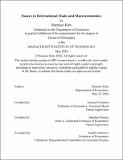| dc.description.abstract | The thesis consists of three essays on international trade, macroeconomics and finance. In the first essay (joint with Marc de la Barrera and Masao Fukui), we study how the interaction between China's productivity growth and currency peg to the US dollar affected the labor market and trade imbalance in the United States. Empirically, we document that in response to similar exposure to Chinese exports, countries pegging to the US dollar experienced larger unemployment and trade deficits compared to floating countries. Theoretically, we develop a dynamic model of trade featuring endogenous imbalances and nominal rigidity, and show that Foreign growth may hurt Home welfare and characterize optimal trade and monetary policy in this environment. Quantitatively, we find that China's currency peg is responsible for 447 thousand manufacturing jobs lost in the US over 2000-2012, one third of the total US trade deficit over the same period, and reduced US lifetime welfare gains from Chinese growth by 32% compared to an economy where an otherwise identically growing China had its currency floating. A short-run safeguard tariff may have effectively accommodated China's currency peg and ameliorated the labor market distortions.
In the second essay (joint with Ying Gao and Marc de la Barrera), we study the Federal Reserve's problem of disclosing the models it uses in supervisory stress tests of large banks. Banks argue that nondisclosure leads to inefficiencies from uncertainty, but regulators are concerned that full disclosure can lead to banks gaming the system. We formalize this trade-off in a stylized model where both the regulator and banks have private ``models" about a risky asset, and the regulator uses its own model to `stress test' the investment. We show that the regulator may benefit from hiding the model when the bank's model is more precise than the regulator's own model. The key idea is that hiding the regulator's model forces the bank to guess it using the bank's own models, effectively eliciting the bank's private information. We also show that if the regulator can fine-tune disclosure policies, the regulator can approximately enforce the first-best action as if the regulator fully knew all the private information held by banks. The intuition is an application of the Cremer and McLean (1988) information rent extraction result.
In the third essay, I investigate the rationale behind East Asian countries' adoption of currency pegging strategies during periods of accelerated growth and explores the optimal peg level in the context of nominal wage rigidity and financial frictions. By developing a policy framework under wage rigidity, imperfect substitution, and exchange rate determination, I find that while the optimal peg level significantly influences real outcomes, standard economic models struggle to rationalize undervalued currency pegs. Potential justifications for an undervalued peg, such as export-driven learning externalities, are explored through numerical simulations. | |
